Navel Orange Tree Care
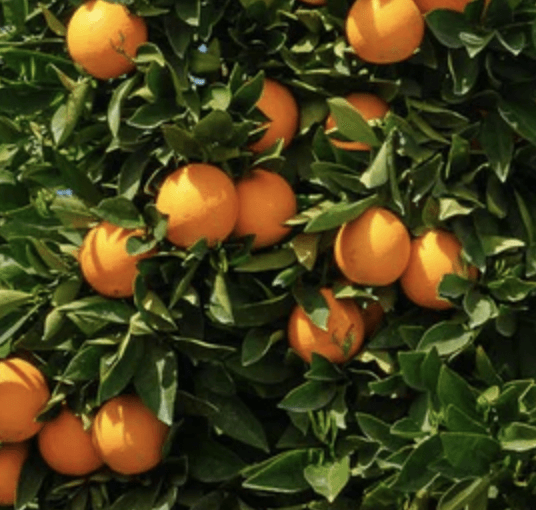
Navel Orange trees are responsible for the iconic oranges you buy in the store. These sweet and seedless fruit trees have tickled tastebuds for a long time. Turns out you can grow navel orange trees right in your own yard. You can no longer have to go to the store to get nutritious and healthy navel oranges. If you want to grow navel orange trees, here's what you need to know.
Quick Facts
| Botanical Name | Citrus Sinensis |
|---|---|
| Common Name | Orange Trees, Navel, Navel Oranges |
| Family | Rutaceae |
| Native Home | Brazil |
| Plant Type | Broadleaf evergreen tree |
| Average Height | 8 to 15 ft. tall |
| Average Width | 8 to 15. ft. wide |
| Varieties | Washington navel orange, Cara Cara |
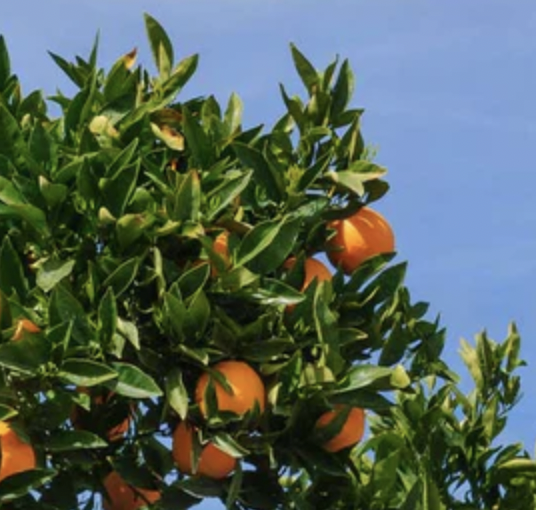
Don't Have Time To Read The Full Article? Here's everything you need to know to take care of NAVEL ORANGE TREES.
- Harvest Period: Annually in Winter or early Spring
- Light: Full Sun
- Water: Moderate
- Soil: Sandy Loam Soil that drains well
- Soil pH: 6.0 to 7.0
- Fertilizer: Balanced fertilizer, or Citrus Blend
- Pests: Mites, thrips, scales, aphids, lepidopterans, Asian Citrus psyllid
- Diseases: Phytophthora root rot, Anthracnose, Botrytis, Huanglongbing (HLB)
- Zone: 9 to 11 (commercially grown in Arizona, California, and Florida)
Table of Contents
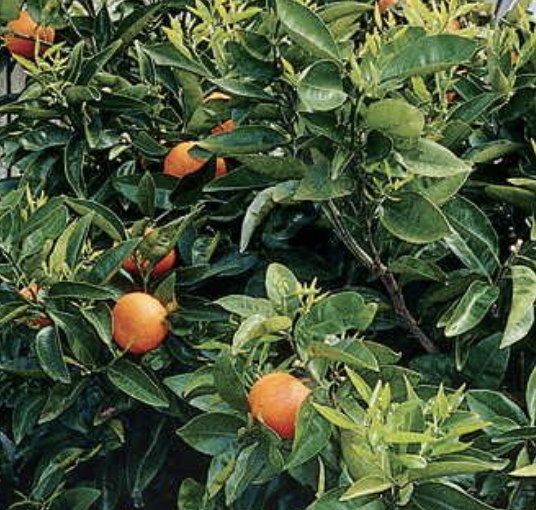
How To Take Care of a Navel Orange Tree
Growing a Navel Orange tree doesn't have to be difficult. Check out the extended care guide below for in-depth tips on how to take care of your trees.
Light
The Navel Orange Tree requires full sunlight or partial sun. It needs to be in direct light for at least 8 hours a day.
Soil
The Navel Orange tree is intolerant of saturated and heavy soils. It prefers soil that drains well and is deep and evenly moist. It likes sandy loamy and slightly acidic soil that sits at a pH of 6.0 to 7.0.
If the soil has poor drainage, you need to plant the Navel Orange tree in a raised bed or large container.
Planting
As with any tree, you want to plant the root ball of the Navel Orange tree at the proper depth.
The best time to plant is going to be from April through August but only if the temperature is not hot. If the temperature is north of 95 degrees Fahrenheit, then don't plant the three.
Navel Oranges are seedless trees. To plant them, they must be planted as a grafted tree.
Leave a few inches of the rootstock above the soil when you plant the grafted tree.
If you decide to transplant a Navel Orange tree be sure to contact your local Agricultural Extension Office to get a hold of the tree law for your area.
Get out the ol' spade and start digging that hole.
Water
Water the Navel Orange Tree once a week in the morning with a soaker or drip irrigation system. You want to make sure the soil is moist but not drenched, and avoid watering the trunk of the tree to prevent rot.
When the tree is developing fruit, you want to make sure it is sufficiently watered. During the winter months, you should reduce the amount of watering or you will overwater the tree.
Temperature
Navel Orange Trees do well in Zones 9 to 11 (and can survive Zone 8 as well), so they can withstand when temperatures drop to 20 degrees Fahrenheit and rise up to 100 degrees Fahrenheit.
On excessively hot summer days, sunburn of the leaves is possible but the damage is usually minimal. It's something the Navel Orange tree can handle and will typically outgrow.
Humidity
Navel Orange trees enjoy humid locations so if you find your trees getting excessively dry then you may need to water over the leaves.
Fertilizer
After you plant your Navel Orange Tree, wait a few weeks before fertilizer. Wait until you see new growth and then proceed to give the plant a nice balanced fertilizer or even a citrus fertilizer every six weeks. Maintain this schedule from February until September.
Harvesting
For young, developing trees you want to pick fruit off the tree for the first few years so that the tree devotes its energy to growing the Navel Orange tree.
Normal harvesting occurs from November through January and even the beginning of Spring. Cold weather encourages the plants to develop more sugars to stay warm which is the reason the plant changes from green to orange.
The only way to know when to pick the fruit is by tasting them. Be sure to get good at this step. Once the plant is harvested, it won't get any sweeter so you want to make sure you pick them at the right time.
Try not to rip the navel oranges off the tree limbs. Pull them up at an angle or use the proper tree shears to avoid damaging the tree. You don't need to get all the fruit in one harvest as the oranges can last a long way before they being to decline in health.
Storing Your Navel Oranges
As you all know, oranges only last about a week at room temperature and up to a month in the refrigerator. Not so ideal for after year of growing and taking care of the tree. Of course, that is gardening after all.
For long-term storage, you are going to have to freeze the oranges. Depending on how you plan to use the fruits, there are a few different ways you can store them. Zest can be frozen for about one year. Juice can be frozen and stored for up to four months.
If you want to keep the fleshy part of the fruit, peel the orange, cut it in slices and store it in a freezer bag. These will last up to a year as well.
Pruning
The Navel Orange tree doesn't require much pruning. Prune your Navel Orange tree about once a year right before new growth occurs in the Spring. Only remove dead, damaged, or crossing branches, nothing excessive. Don't prune your tree too much or you could have problems.
Pests, Diseases and Other Growing Problems
Young Navel Orange Trees just getting established face the toughest challenges of their tree lives. Once they are more mature plants, the tree rarely has any issues.
The Navel Orange tree is susceptible to many problems. Some of its most common foes are aphids, citrus rust mites, fruit flies, mealybugs, and whiteflies; a number of different scales including citrus snow scale, purple scale, Florida red scale, etc.
Diseases that affect the Navel Orange Tree include citrus greening disease, citrus canker, greasy spot, stem-end rot, and sweet orange scabbing.
There's a lot to be wary of when growing the Navel Orange Tree. Look out for the warning signs, and your tree show be okay. If your tree gets injured, it's going to take some time to heal and it might never recover.
Micronutrient Deficiencies
Zinc and iron deficiencies are common with the Navel Orange Tree. If you see yellowing between leaf veins then that is a bad sign.
Check the fertilizer to make sure it includes all the essential required micronutrients. If the fertilizer is okay, check to make sure the pH isn't too basic.
If the pH is too basic (too high), then use an acidifying fertilizer to bring it back down to the optimal pH level of 6.0 to 7.0. High pH can inhibit the absorption of micronutrients and is something to avoid.
About The Navel Orange Tree
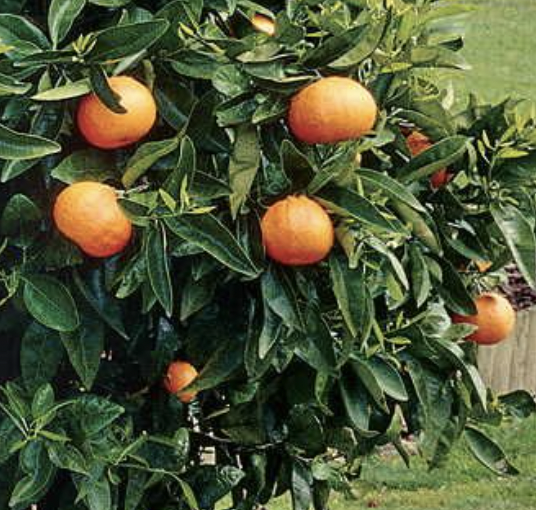
Sweet oranges such as navels, valencias and blood oranges all fall under the botanical name Citrus sinensis. Citrus sinensis is a cross between a mandarin and pummelo that likely happened in Brazil many moons ago.
The original mutation of these fruit trees was found in Brazil sometime in the 1800s. The nice tree was brought back and planted in the United States and dubbed the Washington Navel Orange.
Navels are seedless oranges making them different from other sweet oranges. A mutation on the sweet orange made a small secondary fruit form on the flower end of the fruit. This flower is what gives the "belly button" appearance, hence why the plant is called navel, and also why the navel oranges are seedless.
These evergreen trees can grow up to 30 feet depending on what variety you plant and the quality of the rootstock. They have dark green and waxy leaves that have an elliptical shape. During development, the fruits are green but by the time they are ripe/ready for harvest, they turn bright orange and can grow up to 3" in diameter. Everyone knows of the health benefits of oranges, and that navel oranges are a great source of Vitamin C.
The trees begin to bloom and get into fruit production in the spring. The oranges develop over the summer and fall months and are usually ready to pluck from their trees in winter or the start of spring. The reason they are orange is that the fruits develop more sugars to combat the colder months.
Some different varieties of the navel are the Washington and Cara Cara. The Washington navel orange tree is the oldest variety that still grows today and its fruits are the most common commercialized orange.
A mutation in the Washington navel orange tree led to the creation of the Cara Cara which has a deep pink color instead of the normal orange. Both of these varieties are ready to harvest from November to January.
FAQs
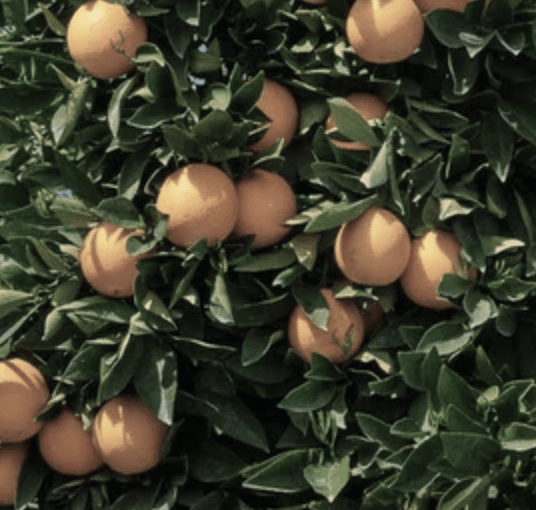
Thanks for stopping by! If you liked this article about Navel Orange Trees, be sure to check out some of our other guides on planting tools, planting zones, tree health, fruit trees and so much more.
Join our community!
Join to receive guides, insights, and the latest gardening deals!
